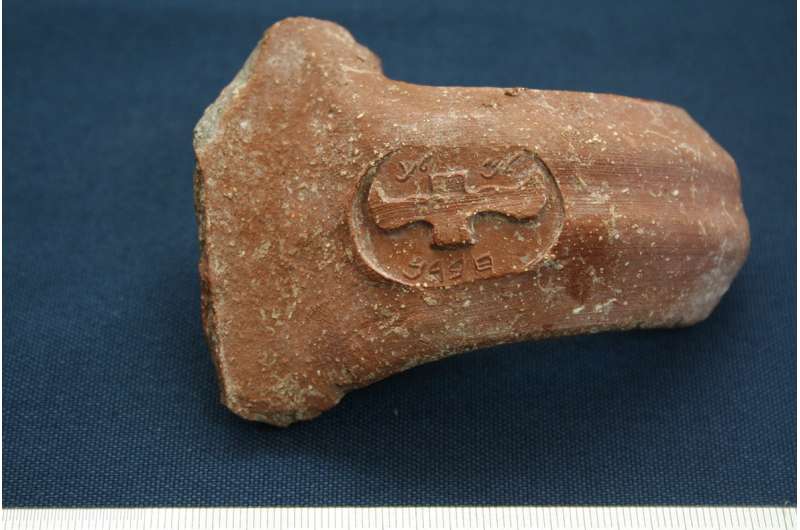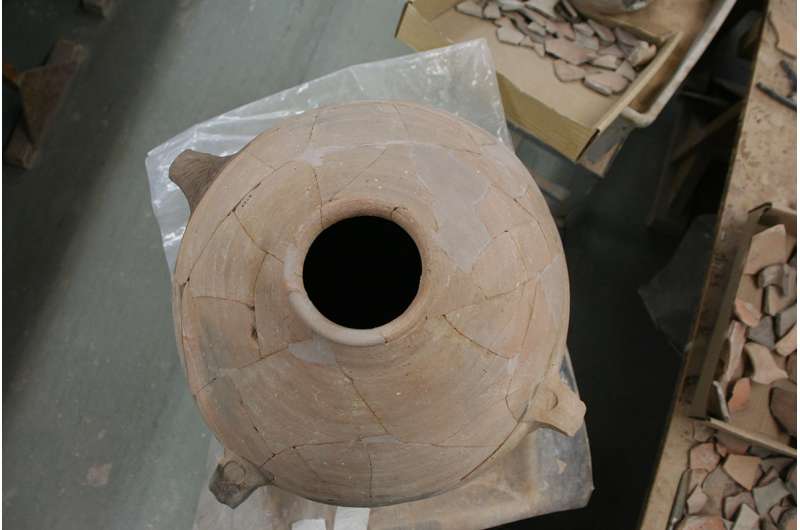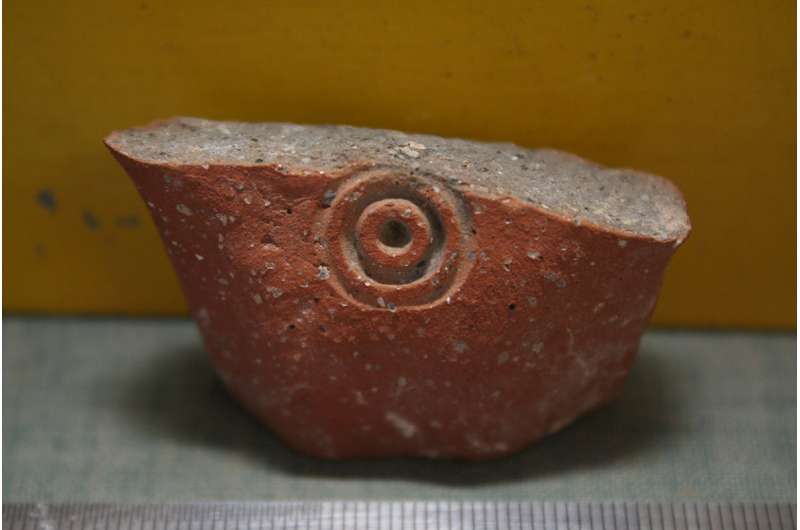Stamped handle from Ramat Rahel. Credit: Oded Lipschits
(Phys.org)—A team of researchers from Tel Aviv University, The Hebrew University and the University of California has used ancient jar handles to chart the strength of the Earth's magnetic field over a 600-year period. In their paper published in Proceedings of the National Academy of Sciences, the team describes how they were able to accurately date the jar handles, which allowed for measuring the geomagnetic field over time.
The geomagnetic field shields life on Earth from a constant stream of cosmic radiation. In this new effort, the researchers sought to learn more about the intensity of the field over time using ancient evidence and to apply this information to understanding how it might behave in the future.
As the team explains, iron oxide particles embedded in clay used to make jars can be used as a measuring device because they become fixed in alignment while the clay is still soft due to the geomagnetic field—once the jar undergoes firing, the particles remain frozen in place. In addition, ancient jar makers stamped and inscribed the handles for tax purposes, leaving clear clues about when they were made. Thus, to create a single measurement, the researchers would date a given jar handle using historical texts, then examine the iron oxide particles to get a reading regarding magnetic strength. By repeating this process for jar handles created between the 6th and 2nd centuries BCE, the team was able to create a magnetic field strength timeline.
The researchers report that the jar handles revealed a gradual reduction in field strength over the course of the six centuries under study, and that there were also spikes and drops in field strength during some time periods. They found, for example, that field strength spiked at the end of the 8th century BEC, and then sagged again afterwards, losing approximately 27 percent of its strength. These fluctuations, the team suggests, indicate that we do not need to be worried about the weakening field that has been observed over the past 180 years—they believe it represents normal fluctuations. The new data may also help planet scientists better understand the nature of the geomagnetic field and to answer some questions, such as why fluctuations and changes in direction occur.
-
Jar from Ramat Rahel with stamp impressions on two different handles. Credit: Oded Lipschits
-
Concentric incision on jar handle from Ramat Rahel. Credit: Oded Lipschits
More information: Erez Ben-Yosef et al. Six centuries of geomagnetic intensity variations recorded by royal Judean stamped jar handles, Proceedings of the National Academy of Sciences (2017). DOI: 10.1073/pnas.1615797114
Abstract
Earth's magnetic field, one of the most enigmatic physical phenomena of the planet, is constantly changing on various time scales, from decades to millennia and longer. The reconstruction of geomagnetic field behavior in periods predating direct observations with modern instrumentation is based on geological and archaeological materials and has the twin challenges of (i) the accuracy of ancient paleomagnetic estimates and (ii) the dating of the archaeological material. Here we address the latter by using a set of storage jar handles (fired clay) stamped by royal seals as part of the ancient administrative system in Judah (Jerusalem and its vicinity). The typology of the stamp impressions, which corresponds to changes in the political entities ruling this area, provides excellent age constraints for the firing event of these artifacts. Together with rigorous paleomagnetic experimental procedures, this study yielded an unparalleled record of the geomagnetic field intensity during the eighth to second centuries BCE. The new record constitutes a substantial advance in our knowledge of past geomagnetic field variations in the southern Levant. Although it demonstrates a relatively stable and gradually declining field during the sixth to second centuries BCE, the new record provides further support for a short interval of extreme high values during the late eighth century BCE. The rate of change during this "geomagnetic spike" [defined as virtual axial dipole moment > 160 ZAm2 (1021 Am2)] is further constrained by the new data, which indicate an extremely rapid weakening of the field (losing ∼27% of its strength over ca. 30 y).
Journal information: Proceedings of the National Academy of Sciences
© 2017 Phys.org
























